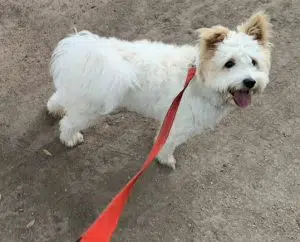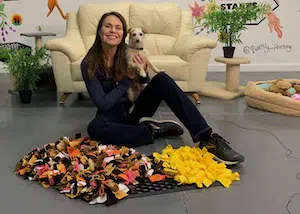
Training tips for rescue dogs aren’t necessarily that different to training a puppy or an older dog.
However, given you won’t know the previous life experiences, good and bad, that your rescue dog has been through and how this may impact on their behaviour, there can be a few extra challenges.
Particularly, as past experiences may be influencing their current behaviour and affect how they respond to certain training methods or activities you are asking them to perform.
Sadly, many are labelled ‘aggressive’ when their reactivity is coming from a place of fear and anxiety, so you need to start slowly with their socialisation with other people and dogs. For more information about fear-based reactivity, click here.
If you have had a well trained dog before, your approach to the training of a rescue dog will be a new experience and will require plenty of patience and understanding to determine any physical or emotional issues they may be experiencing, or how much training they may or may not have had to date.
Having owned a couple of rescue dogs myself, I know just how much unconditional love and gratitude they have to give, how eager they are to please you and that it is most certainly possible to train a dog new lessons at any age.
It all comes down to understanding their current levels of learning, any anxiety, phobias and triggers they may have and being a kind and consistent leader.
Timing is crucial
Training needs to be fun for both parties
Training and manners
To find out how much your dog already knows about a command try using either a verbal command or a hand signal. Rule of thumb is to say the command with the appropriate hand signal, and if the dog doesn’t respond, repeat after 10 seconds and try again. Try these commands to find out how much they may or may not already know and are confident at performing:
Sit – This command is like saying ‘please’. It’s perfect for before meals, while humans are eating meals, before the lead gets clipped on, when you have visitors, and at a curb when crossing a road.
Stay – Stay is a direction for your dog to wait somewhere. Useful for the coffee shop or for when you have visitors, or to keep them safe from harm.
Lie Down or Drop – This command is useful in many settings from the vet, to a cafe. Try both verbal commands ‘lie down’ and ‘drop’ to see if they respond to either of these.
Come – The most important command to see how good or bad they are at coming back to you. Make sure test this at home in your backyard or a secure area first. Teaching your dog recall is vital to keep it safe from dangers like the road or other animals. Read more tips on developing recall in your rescue dog here.
If your dog is not having any recognition of these verbal or hand signals then you should go back to some basic training for things like a sit, recall and even ‘yuck’ or ‘leave it’ which can stop them from picking up food that may be contaminated, and develop good behaviour around food in general.
It’s not uncommon for adult dogs to get confused when it comes to toilet training when they’re living in a new home. This is often even more so when a rescue dog has come from a shelter environment where they’re used to toileting inside their own enclosures so any previous training they may have had has been undone.
Tips include supervising toileting for the first few weeks, creating a toileting routine, rewarding with treats after a successful toilet run and cleaning up accidents with products that don’t contain ammonia.
For more tips on going back to the basics with toilet training, click here.
Some other general training tips and preparation tips for rescue dogs are much the same as those for puppies, so have a read through our preparing for a puppy article to ensure you are prepared for your rescue dog, as well as how to dog proof your home.
It is important to also understand anxiety in dogs as it is something that many rescue dogs do have, noise-related phobias , and why your rescue dog may be displaying some bad behaviour and what to do about it. For additional information and tips on barking which can be a common issue with rescue dogs click here.
It is important that any training is undertaken with the right care and experience to help ensure problems aren’t made worse, so do seek out the services of a qualified and experienced dog training or vet behaviourist to assist.
Visit the NDTF Find a Trainer page here to find someone local to you or call them to see if they can recommend anyone not listed.
About the Author: Lara Shannon is a certified dog behaviourist and trainer, pet food nutrition specialist, Executive Producer and Host of Pooches at Play on Channel 10 and editor of Poochesatplay.com. Lara also runs her own dog training business in Melbourne’s Bayside area and is the Author of World of Dogs and Eat, Play, Love Your Dog


Walking a dog – how much and why

The benefits of Snuffle Mats for dogs


Toilet Training a Puppy for success


Get your paws on Lara Shannon’s best selling books ‘Eat, Play, Love (your dog) and World of Dogs.
Available in Australia, USA, UK and Canada.